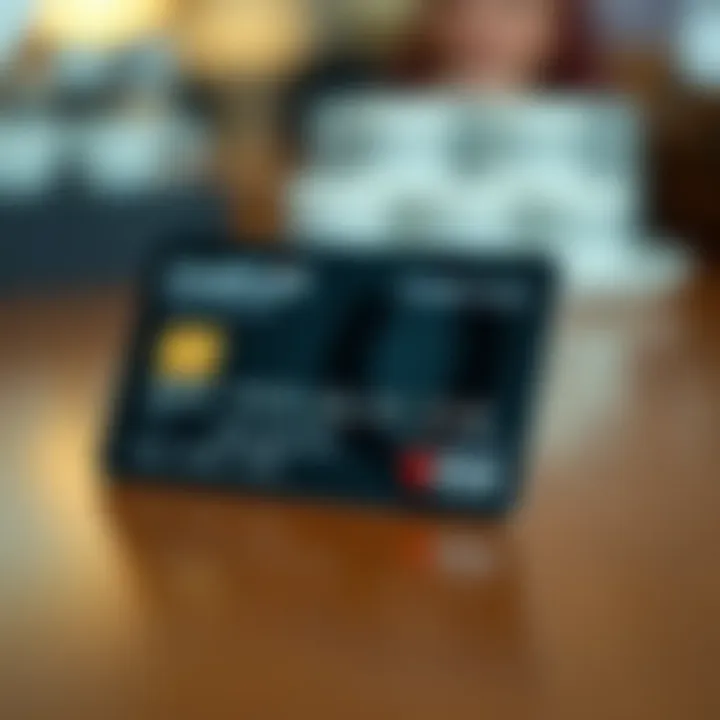Top Strategies to Protect Your Credit Card Data


Intro
As the world moves towards a cashless society, our reliance on credit cards for everyday transactions has skyrocketed. However, this convenience brings with it a host of risks. One particularly insidious threat is the unauthorized scanning of credit cards. Imagine walking through a crowded market or public transport, and someone, with their stealthy devices, snatches your credit card info without you even noticing. The truth is, as technology evolves, so do the tactics of criminals looking to exploit it. Thus, understanding how to protect your card is paramount for maintaining financial safety.
In this article, we will cover various angles on safeguarding your credit card from unwanted scanning. We'll explore the technology behind these scams, discuss practical tips for everyday behaviors, and review advanced security measures to fortify your defenses. The goal is to educate readers so they can take proactive steps to mitigate risks and protect their financial well-being in our increasingly digital landscape.
Key Terms and Definitions
To begin with, it’s essential to understand some key terms related to credit card security:
- RFID (Radio-Frequency Identification): A technology used for wireless communication that allows credit card information to be transmitted to a card reader. While convenient, it can also be a gateway for thieves.
- NFC (Near Field Communication): Similar to RFID, this technology is employed for contactless payments. It allows two devices to communicate when they are close to each other.
- Skimming: The act of illegally copying data from a credit card's magnetic strip. Skimmers can be attached to ATMs or point-of-sale terminals, capturing your card's information when you swipe.
Understanding these terms is important as they form the foundation for our discussions on how to secure your credit card data.
Recognizing the Risks
Credit card scanning is not a new phenomenon, but it has become more sophisticated and widespread. Awareness of how these scams work can be a powerful defense. Here are some risk factors to consider:
- Public Areas: Cafés, airports, and other crowded places are prime spots for scammers.
- Old Technology: Older credit cards without security features like RFID-blocking may be more vulnerable.
- Weak Passwords: For online shopping, reusing passwords or using weak ones can lead to additional risks beyond just credit cards.
By keeping these factors in mind, you can better assess and navigate situations where your card may be at risk.
Protective Measures
So, what can be done to protect your credit card from scanning? Here are practical tips that can be easily implemented:
- Use RFID-Blocking Wallets: Invest in a wallet designed to block RFID signals. This offers an additional layer of security against unauthorized scans.
- Monitor Your Accounts Regularly: Keep a close eye on your account statements for any unusual charges. The sooner you catch unauthorized spending, the better.
- Avoid Public Wi-Fi for Transactions: Security can be compromised on unsecured networks, so steer clear of making online purchases when using public Wi-Fi.
Remember, an ounce of prevention is worth a pound of cure. Taking small steps today can save you from larger headaches down the road.
Advanced Security Options
For the more tech-savvy readers or those looking for additional protective measures, advanced options may be a consideration. These include:
- Virtual Credit Cards: Some banks provide virtual card numbers for online transactions, which can be used instead of your physical card.
- Two-Factor Authentication: Always enable two-factor authentication for accounts linked to your credit card. This adds another step to verifying your identity.
- Mobile Payment Systems: Consider using services like Apple Pay or Google Wallet, which typically have enhanced security features compared to traditional credit card transactions.
These methods not only help in securing your transactions but can also minimize the impact if a security breach occurs.
Epilogue
In summary, as the landscape of financial transactions continues to shift towards the digital, awareness and proactive measures are indispensable for protecting your credit cards. By grasping the risks and embracing innovative protective strategies, you arm yourself against potential threats in this cashless environment. Understanding your credit card security can transform from a daunting task into a manageable habit, ensuring your financial safety in the long run.
Prolusion to Credit Card Scanning Risks
In today’s fast-paced world, the convenience of credit cards has made them a staple in financial transactions. However, with this convenience comes significant risks. Scanning regulations and techniques have become increasingly sophisticated, posing a genuine threat to personal information and financial security. This discussion will take a closer look at the various dangers associated with unauthorized credit card scanning, aiming to emphasize the urgent necessity for vigilance in securing one’s credit card data.
The importance of recognizing the inherent risks tied to credit card scanning cannot be overstated. Many people often underestimate the ease with which their sensitive information can be accessed. For instance, the advent of RFID technology, while offering seamless transactions, has also opened doors for nefarious activities. Credit card skimmers can easily harvest your data without necessitating physical contact. Just imagine someone with a small handheld device walking past you in a crowded area, surreptitiously capturing your card information without you even noticing a thing.
Key Considerations:
- Increased Risk of Fraud: As more individuals adopt contactless payment methods, the risk of fraud simultaneously escalates.
- Lack of Awareness: Consumers frequently remain unaware of how prevalent these scanning risks are, often brushing aside suspicions without taking precautionary measures.
- Technological Advances: While technology brings many advantages, it also equips criminals with new tools to commit fraudulent acts. Being informed about these advancements is vital.
- Financial Consequences: Beyond mere inconvenience, the aftermath of credit card fraud can lead to considerable financial losses, impacting your credit score and future borrowing capabilities.
"Preventing fraud before it happens is always better than dealing with the repercussions later."
Being proactive is the key to safeguarding your financial assets. Therefore, understanding scanning risks should be the first chapter in the journey toward ensuring that personal financial security is uncompromised. As we delve deeper into this subject, it becomes clear that if we want to keep our finances out of harm’s way, we must adopt a mindset of vigilance and responsibility.
Understanding RFID Technology
In the realm of modern finance, understanding the nuances of Radio-Frequency Identification (RFID) technology is critical for anyone wary of unauthorized credit card scanning. RFID technology has transformed how transactions are processed, making them quicker and fostering a certain convenience that many consumers appreciate. However, with this convenience comes a set of vulnerabilities that can jeopardize one's financial data. Therefore, gaining insight into how RFID works not only enlightens consumers about the potential risks but also empowers them to take proactive measures against scanning.


What is RFID?
RFID is a technology that uses electromagnetic fields to automatically identify and track tags attached to objects. These tags can either be active, containing their own power source, or passive, receiving power from the scanning device. In the case of credit cards, RFID tags are usually passive. They hold crucial information, such as card numbers and expiry dates, and can transmit this data wirelessly. This technology is not restricted to financial transactions; it also finds application in inventory management and access control systems, among others.
Understanding RFID isn't merely a technical exercise; it plays a significant role in the way consumers interact with the financial system. With contactless payments privileged by RFID, customers can tap a card against a reader to authorize payments swiftly. While beneficial, a lack of awareness about how RFID functions can lead to mishaps, including unauthorized transactions.
How RFID Scanners Work
RFID scanners operate by emitting a radio signal that triggers a response from nearby RFID tags. This means that when you place your card near a payment terminal, the scanner sends out a signal, and the card responds by sending back its data. The entire process occurs in a matter of milliseconds, which is why many appreciate it. However, the very nature of this technology makes it vulnerable. An unauthorized individual with a scanner can potentially intercept the signal, accessing your card information without even needing to touch your card.
Here are some key points on how scanners work:
- Emission of Signal: The RFID scanner emits a signal.
- Collection of Data: The nearby RFID tag receives this signal and transmits back the stored information.
- Transaction Processing: The terminal processes the information, completing the transaction swiftly.
By understanding these mechanics, users can better appreciate the risks and adopt methods to safeguard against them.
Applications of RFID in Payment Systems
RFID technology has permeated various sectors, but its role in payment systems is remarkably noteworthy. From speeding up transactions in busy retail environments to enhancing customer experiences through efficiency, RFID serves strategic functions:
- Contactless Payments: Many modern credit cards come with RFID technology, allowing consumers to pay just by tapping their card at a reader.
- Seamless Transactions: Customers can execute transactions without the need to enter a PIN or sign, saving valuable time.
- Increased Adoption: The growing presence of RFID in payment systems has led many businesses to adopt this technology, enhancing convenience for consumers.
Despite these benefits, the pervasive use of RFID in payments calls for critical vigilance regarding security. Being informed about the mechanics of RFID helps users understand their risks and equips them to take meaningful steps to protect their assets against unauthorized scanning.
Identifying Common Scanning Methods
Understanding the techniques behind credit card scanning is pivotal in safeguarding your financial data. The world is increasingly digital, and with it, the methods used by fraudsters evolve constantly. By pinpointing these common scanning methods, you not only become more aware of the risks that threaten your card details but also empower yourself to make informed decisions on how to protect them.
Skimming Devices
Skimming is one of the most prevalent methods employed by criminals to siphon off credit card information. At its core, a skimming device is a small electronic gadget that can capture the data stored in the magnetic stripe of your card. These devices are often disguised, making them difficult to detect. For instance, you might find one attached to an ATM or gas station card reader, almost camouflaged alongside legitimate equipment.
The process is deceptively simple; the thief just needs a brief moment with your card near the skimming device to collect your information. This data can then be transferred to create a counterfeit card or used for online purchases.
To protect yourself from skimming:
- Always inspect card readers before use. If anything looks off, don't use it.
- Cover your hand while typing in your PIN to prevent hidden cameras from capturing it.
- Consider using ATMs located within bank branches, which are generally safer.
Contactless Payment Exploits
Contactless payments have revolutionized how we transact, thanks to their convenience. Yet, this very convenience can turn into a double-edged sword. As cards equipped with RFID technology gain popularity, so do the opportunities for exploitation. Scammers can utilize handheld devices that can read the RFID signals from your card without even needing to touch it. This means that, with the right equipment, they could potentially swipe your information while you're just standing nearby.
To combat this, there are a few strategies you can consider.
- Invest in RFID-blocking wallets or cards to mitigate the risk of unauthorized scans.
- Be mindful of your surroundings. If someone seems overly interested in your personal space, it may be wise to move or shift your positioning.
- Keep your cards in a secure location within your bag where RFID signals cannot easily reach them.
"Awareness is your first line of defense. Understanding how criminals operate can help you stay one step ahead."
Everyday Practices to Enhance Security
In the realm of credit card security, daily habits can make a monumental difference. You don't need to be a tech whiz to protect your finances; simple adjustments to how you handle your credit cards can significantly cut the risk of unauthorized scanning and potential fraud. The importance of being proactive cannot be overstated. Just like locking your door when you leave the house, these practices create a barrier between you and cybercriminals.
Awareness in Public Spaces
It’s crucial to stay alert when you're out and about. Crowded places like shopping malls, cafes, or public transport hubs present ripe opportunities for thieves looking to skim information. Keep your credit cards close to your body; consider using a front pocket instead of your bag for quick access. If you need to input your PIN at a terminal, shield your hand with your body or other items, preventing onlookers, including potential scammers, from seeing your confidential numbers.
Moreover, be mindful of your surroundings when using your card. A thief equipped with a portable scanner often appears harmless. They might hover too close during transactions; don’t hesitate to change locations or move to an area where you feel more secure. Staying alert is about more than just protecting your personal data; it's about being aware of the subtle signals that something is off. As they say, "better safe than sorry."
Managing Transactions Cautiously


Every swipe or tap of your card is a transaction that can be monitored by hackers. Take charge of your financial activity by being judicious with where you use your credit card. Only shop from reputable sources—this goes for online and offline transactions. If a deal seems too good to be true, it probably is. Look for signs like HTTPS in web addresses or feedback from previous customers.
When possible, opt for secured payment methods, especially for online purchases. Using services like PayPal can add an extra layer of security, as they act as intermediaries and don’t expose your credit card information directly. Moreover, avoid lending your card to anyone who doesn't absolutely need it. It might feel like a small gesture of trust, but it can have larger implications.
Regular Account Monitoring
Keeping a close eye on your credit card statements is not just prudent—it's essential. Monitor transactions frequently to catch any suspicious activity right away. Most banks offer mobile apps or online banking services that allow for real-time notifications of spending. If you notice transactions that don't match, report them immediately. As the saying goes, "an ounce of prevention is worth a pound of cure."
Schedule a routine, like checking your accounts weekly, to familiarize yourself with your spending habits. Knowing your financial landscape will help in identifying irregularities. If unfortunate incidents happen—and they can—understanding your rights as a cardholder will be invaluable. Crediting the right authorities promptly can halt possible disaster and prevent further damage.
"Being aware, cautious, and vigilant is not just a good idea; it's your first line of defense in a world where cyber threats are becoming more sophisticated."
In summary, adopting everyday practices focused on awareness, cautiousness, and regular monitoring can significantly enhance your credit card security. These small, yet impactful changes to your routine can protect your financial health and stave off potential threats.
Utilizing Protective Measures
When it comes to safeguarding your credit card from unauthorized scanning, employing protective measures is paramount. The digital age has brought countless conveniences, but it has also upped the ante in terms of security risks. By taking proactive steps, you place a solid barrier between your sensitive information and potential criminals. In this section, we’ll dissect several effective protective strategies, each designed to enhance your financial security and instill a sense of control over your transactions.
RFID-Blocking Wallets
The rise of RFID technology has certainly made transactions smoother, but it also makes you prone to scams. RFID-blocking wallets come into play as a crucial defensive tool. These wallets are embedded with materials that block electromagnetic fields, preventing unauthorized scanners from reading your card's information.
When choosing an RFID-blocking wallet, consider the design and capacity that suits your lifestyle. You might discover sleek options that don’t sacrifice elegance for security. Additionally, ensure the wallet is made of high-quality materials, as durability is key in protecting your valuable cards. It's like wearing an invisible shield; the wallet keeps your information safe, so the bad guys can’t take a peek. Don’t let convenience come at the cost of safety—opt for a wallet that marries style with security.
Credit Card Sleeves
Just as an artist uses a paintbrush, you need the right tools for protection. Enter credit card sleeves. These lightweight and portable solutions can be slipped over your cards for an extra layer of security. They work similarly to RFID-blocking wallets but provide flexibility, as you can use them with any card.
Credit card sleeves come in various designs and materials—be it plastic or fabric—so you can select one that reflects your style. Plus, they are easy to carry around; just toss them in your purse or pocket. When you’re ready to make a purchase, simply slide your card out, and the sleeve remains a silent partner, guarding against potential scans every time.
Smartphone Apps for Alerts
In the digital world, a wise person keeps their ear to the ground. Smartphone apps that send transaction alerts are invaluable when it comes to tracking your spending and potential fraud. Set up alerts to notify you of any transactions made with your card, and you'll be alerted faster than a hawk spotting its prey.
Why is this important? It offers you peace of mind—the kind that tells you your financial information is in safe hands (yours). Make sure to research and select apps that suit your needs, whether those focus on budgeting or fraud monitoring. The right app can act like a loyal watchdog, barking at any suspicious activity, allowing you to take action promptly.
Take control of your financial safety with these protective measures. The right wallet, sleeve, and mobile app can give you the upper hand in combating unauthorized access to your sensitive information.
Utilizing these protective measures isn't just about enhancing your security; it also lets you navigate the market with confidence, knowing you're one step ahead of potential threats. As we advance, understanding how to combine these options will fortify your defenses against unwanted scanning.
Advanced Security Solutions
In today's increasingly digital landscape, protecting your credit card information has never been more essential. With hackers and scam artists continuously coming up with sophisticated methods to steal data, it is crucial to consider advanced security solutions that go beyond standard practices. These solutions are designed to safeguard your sensitive information, providing an additional layer of protection against unauthorized access. They also enhance your peace of mind knowing that there are measures in place to help prevent fraud.
Two-Factor Authentication
One of the most effective tools for boosting the security of your credit card transactions is Two-Factor Authentication (2FA). This method requires not just your password but a second factor to verify your identity. It might be a temporary code sent to your mobile phone, or it could be an authentication app generating codes that change every thirty seconds.
Benefits of Two-Factor Authentication:
- Adds another barrier for hackers, making it harder for them to gain access
- Provides real-time notifications of any failed login attempts
- Many institutions and services now offer this feature, giving you more options
When you are using online payment services or managing your credit card details through apps, always choose to enable 2FA. It’s a straightforward yet highly effective way to ensure that only you can access your accounts, even if someone somehow gets hold of your password.
Transaction Alerts
Transaction alerts serve as another strong line of defense against credit card fraud. Many banks and card issuers allow you to set up instant notifications every time a purchase is made. This ensures that you can keep an eye on your spending and detect any strange activity almost immediately.
Why Transaction Alerts Matter:


- They keep you informed about every purchase, big or small
- Immediate notifications help you track unauthorized transactions right away
- You can quickly report fraud to your bank, minimizing damage
Setting these alerts is typically a quick process through your bank’s app or website. You can customize them according to your preferences, such as receiving a message for transactions over a specific amount or alerts for international purchases.
"Being proactive is crucial. With both two-factor authentication and transaction alerts, you're not just waiting for something to happen; you're in control of protecting your financial well-being."
Choosing the Right Credit Card
Choosing the right credit card is a fundamental move for anyone wanting to safeguard their financial health. With a multitude of options available, each card often comes with distinctive features, benefits, and potential risks, especially regarding the susceptibility to scanning. It’s essential to align the choice of card with both personal spending habits and security needs. By doing this, consumers can not only enhance their financial management and benefits but also mitigate risks related to unauthorized access.
Evaluating Features and Benefits
When evaluating credit cards, it’s crucial to deeply consider the various features that each card offers. Here are some key aspects:
- Interest Rates: Low-interest rates can save you money, especially if you carry a balance. Look for cards that offer an introductory 0% APR on balance transfers.
- Reward Programs: Many credit cards offer cashback, travel points, or other rewards. Choosing a card that aligns with your spending habits can maximize your benefits.
- Security Features: Some cards come equipped with advanced security features such as fraud alerts, two-factor authentication, and instant transaction alerts. These can be significant deterrents against unauthorized scanning and fraudulent transactions.
- Fees: Pay attention to annual fees, foreign transaction fees, and late payment penalties. Sometimes, higher fees can be justified by great rewards or lower interest rates, but it’s wise to avoid hidden charges whenever possible.
A thorough evaluation will allow you to balance the pros and cons effectively, making it easier to find that ideal card for your needs. Always read reviews and check third-party evaluations to gather more insights.
Understanding Fraud Liability Policies
Understanding fraud liability policies can make all the difference in protecting yourself against unauthorized charges. Each issuer has different policies surrounding fraud, and it is essential to know what you are covered for:
- Zero Liability Policy: This means you won’t be held responsible for any unauthorized transactions as long as you report them in a timely manner. Most major credit card companies, like Visa and Mastercard, have these policies in place.
- Reporting Timeframes: Familiarize yourself with the timeframe in which you need to report fraud for it to be covered under the liability policy. Some issuers may require that you alert them within a certain number of days.
- Contact Information: Keep the contact information of your credit card provider easily accessible. In an emergency, being able to report suspicious activity swiftly can save you a lot of trouble.
In summary, navigating through the nuances of credit card options and their fraud protection features can pave the way to better security. Not only does this process empower you with knowledge, but it also lays the groundwork for being financially smart while staying protected against threats like credit card scanning.
Remember, the more informed you are, the better equipped you'll be to make choices that protect your financial future.
For further research, check out resources like Consumer Financial Protection Bureau for a detailed understanding of credit card policies and protections.
Legislation and Consumer Rights
Understanding the realm of legislation and consumer rights is crucial for anyone who relies on credit card transactions. This topic carries immense significance because it empowers individuals with knowledge of their rights in relation to unauthorized scanning and theft. Every consumer is entitled to protection under the law, and laws surrounding financial transactions are designed to prevent fraud while fostering a sense of security in the marketplace.
Consumer protection laws provide a safety net, ensuring that individuals are not held liable for fraudulent charges if they report them in a timely manner. Regulations set by authorities, such as the Federal Trade Commission (FTC) in the United States, funnel down to the nitty-gritty, dictating how financial institutions should treat consumers during instances of fraud. These laws are in place to protect your hard-earned money from dishonest practices, giving people confidence to engage in cashless transactions.
Understanding Consumer Protection Laws
Consumer protection laws are layered and can vary greatly depending on the jurisdiction. In general, they create a framework that allows credit card users to reclaim lost funds due to unauthorized charges. For instance, the Electronic Fund Transfer Act (EFTA) outlines measures for notifying consumers about their rights and the responsibility of banks regarding these transactions. One key aspect is that if a consumer reports unauthorized use in a timely fashion, they are generally only liable for a limited amount, often capped at $50.
Moreover, laws provide an avenue for victims to dispute charges. When consumers notice unauthorized transactions, they can take action to ensure that their money is retrieved. The Fair Credit Billing Act (FCBA) complements these protections by allowing consumers to challenge billing errors. This legislation enables credit card holders not only to challenge unauthorized charges but also to rectify payment mistakes made by merchants, fostering a fair marketplace.
Reporting Credit Card Fraud
Knowing how to report credit card fraud is of utmost importance in protecting oneself. The process begins simply: once an unauthorized transaction is noticed, the first step is to reach out to the card issuer. Most companies offer 24/7 customer service for such emergencies. A few minutes on the phone could save you a world of trouble.
Let’s break down the steps you should take:
- Contact your card issuer immediately: Report the fraud as soon as possible. Be prepared to provide details, like transaction amounts and dates.
- Monitor your account closely: After reporting, keep an eye on your statement for any additional suspicious activity.
- Follow up with a written notice: Sending a written dispute to your issuer can solidify your claims.
- Check your credit report: Seeing if any accounts were opened without your consent is crucial. Visit AnnualCreditReport.com to access your credit report for free once a year.
- Alert credit agencies: If necessary, place a fraud alert on your credit reports to prevent identity theft.
"Timely reporting can mean the difference between loss and recovery. Understanding your rights is the first step in securing your financial future."
Culmination
By familiarizing yourself with legislation and consumer rights regarding credit card use, you place yourself in a strong position against potential fraud threats. Knowledge of your rights allows swift action to mitigate financial losses and emphasizes the importance of responsible usage of your credit card. With laws like the EFTA and FCBA standing guard, consumers can feel assured that they have a robust support system should any challenges arise.
Finale
In today's fast-paced, technology-driven world, protecting your credit card information from scanning is not just advisable; it’s essential. As credit cards have become a central tool for financial transactions, understanding how to safeguard this information becomes paramount. With the increasing sophistication of scanning techniques, it’s vital to remain one step ahead in the game.
This article has highlighted various strategies that aim to protect your sensitive data. From everyday habits to advanced technological solutions, each facet plays a critical role in reducing vulnerability. Awareness, careful transaction management, and using protective devices serve as first lines of defense against potential fraudsters. Moreover, keeping up with the latest trends in technology and legislative measures is equally important to equip yourself with the knowledge needed to navigate this landscape.
- Behavioral Awareness: Understanding your environment while using your credit card can significantly diminish risk. Whether it’s choosing secure locations for transactions or being vigilant about proximity to suspicious individuals, these practices matter.
- Protective Devices: Utilizing RFID-blocking wallets or sleeves can dramatically reduce the chances of unauthorized access to your card data. While they might seem like an added cost, they can save you from potential theft, making them a worthy investment.
- Technological Solutions: Embracing software that provides transaction alerts and two-factor authentication enhances security measurably, notifying you of any unusual activities right away.
The relevance of these strategies cannot be overstated. Combine them with an understanding of your rights as a consumer under various fraud liability policies, and one can create a robust defense against credit card scanning. Armed with this knowledge, you not only protect your finances but also contribute to maintaining overall digital security awareness.
In summary, being proactive about credit card safety is fundamental. No one wants to deal with the aftermath of fraud, but with the right strategies and informed choices, you can navigate your financial transactions with greater confidence.



